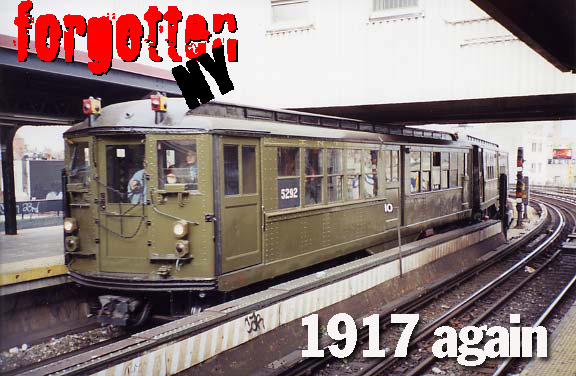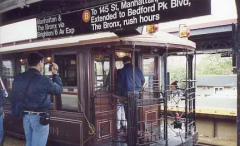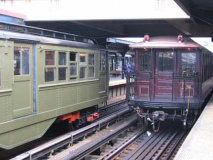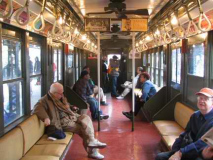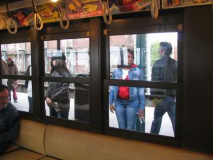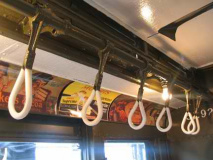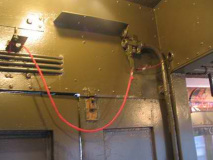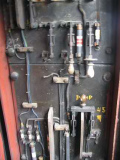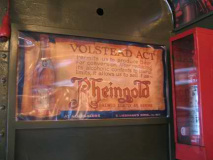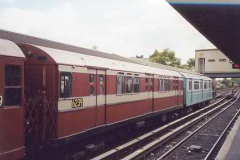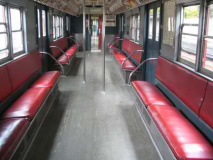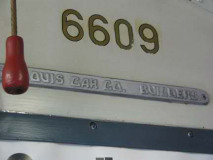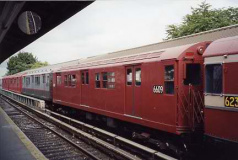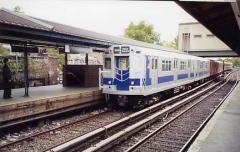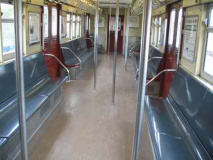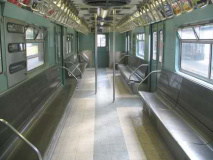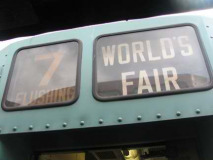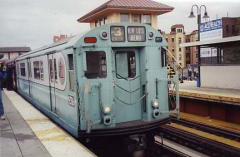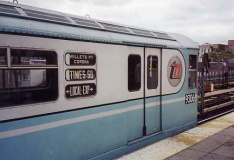Fresh from its 1930 IND and Brooklyn elevated car fantrip to Rockaway Park, the MTA continued its centennial celebration on October 23, 2004 with a run of elevated and subway cars from four decades, on the Brighton Line in Brooklyn in what it referred to as the “Cavalcade of Stars.” The IRT low-V car No. 5292, straight outta 1917, arrives at Brighton Beach in the photo seen above.
I’m not a train geek. I’m a New York geek. My primary interest in the subways has been its condition as the world’s biggest museum with its remaining ancient signage, design, and abandoned and underused stations and lines. Yet, riding for hours on these old cars that have been lovingly and painstakingly restored to running condition, and repainted and reappointed as they were when they first ran, I suppose that I find myself awash in a reverie of retro-nostalgia: the remembrance of things and events that happened before your own experience.
When I first started riding the trains in the Swingin’ Sixties, we were in the tail-end of era of the ceiling fan, porcelain handhold, wicker-seated cars we’ve seen this fall as the MTA celebrates its legacy. But that wasn’t my sybway era. The TA, as it was called then, had begun gradually easing out detail as early as the 1940s. By the 1970s, waves of financial crises and yes, neglect and willful destruction on the part of the public, had left our public transportation was the graffiti-scarred and reeking of urine. There were track fires, station closings; I remember subway cars identified by letters scrawled on paper taped to the railfan windows™. Perhaps I preferred to think subway cars the way they were from the days of my earliest childhood…maybe I wanted the next stop to be Willoughby instead of Pacific Street.
So I can be forgiven if I became a train geek for a couple of fall afternoons. Train geeks don’t tag windows and they don’t urinate in the underground corridors. They ride trains and take pictures, and whether the cops like it or not, they always will.
The Cavalcade featured Brooklyn Union elevated gate cars 1273, 1404 and 1407, as we’ve seen in their trip to Far Rockaway.
The el cars and the IRT Low-V cars 5290 & 5292, built in 1917, and 5483 & 5443, built in 1924 and rolling until the 1960s, were the stars of the show. These were in the first generation of steel-clad rolling stock. The cars had lower-voltage, “Low-V” 32-40 volt battery boxes, as opposed to higher voltage control gear of their predecessors, the IRT Composite cars (among which was August Belmont‘s private car, the Mineola, the most lavish subway car ever built).
Inside it’s 1917, outside it’s 2004. The low-V cars were restored by a team of repairmen headed by the retired supervisor Mike Hanna and a volunteer crew of retired colleagues, train buffs and friends, who had worked on low-V’s in their waning years in the 1960s. Steel was replaced, fans repaired, new lightbulbs installed (subway bulbs have reverse crews to discourage theft); new glass was put in place, and handholds were brought in from train museums in Pennsylvania, California, Connecticut and Maine. Weatherguard Marbleoid, a Bronx company, was called in to restore the floors. The same company had worked on the low-Vs nearly 90 years ago.
The low-Vs had longitudinal seating, a practice repeated by their latterday cousins. RIGHT: the handholds replicate the 1917 models.
A look at low-V electrical and mechanical gear, hidden behind movable panels in the motorman’s cab.
Most beer companies survived between 1919 and 1933, after the passage of the Volstead Act enforcing the new 18th Constitutional Amendment, by producing “near-beer” that had little enough alcoholic content to “lawful limits.” Taste but no buzz.
The IRT R-15 series was introduced in 1950 by American Car & Foundry. This car, 6239, was the subways’ first air-conditioned unit. Air-conditioning, however, would not be truly frequent in the subways until the late 1970s and not universal until late 2003.
The R-15s appropriated the unique “porthole” windows on the doors first introduced earlier, in the IND R-11 stainless steel cars. Its three windows between the doors give it an airiness that other series’ boxier windows do not. The R-15s numbered 6216-6225 were the first NYC subways cars delivered with a PA system (obviously, subway PA systems have never been perfected). The red upholstery came from a latterday Transit Museum renovation.
The exterior might resemble an R-33/R-36 Redbird but #6609 is actually from the earlier R-17 series by the St. Louis Car Co., introduced in 1955 on the IRT and retired in 1988. The windows had become smaller by 1955.
“Redbirds” weren’t always red. They were painted a variety of colors, including red, since being put into service in 1962. In the 1980s, the MTA whitewashed some of them, apparently trying to baffle graffitists. No luck. Through most of their use the R-33s and their partners, the R-36s, sported a gray and blue striped look. At the dawn of the “repainted” redbird era in the mid-1980s, there were actually some greenbirds. The cars were also built by St. Louis Car.
Don’t call them “bluebirds.” #9306 was the first in the R-33 “World’s Fair” cars that were introduced in 1962 and later painted aqua blue to match the overall promotional theme color for the 1964-65 NYC World’s Fair in Flushing Meadows/Corona Park. A few of these cars carried names of states; the states’ Fair sites had paid to promote them on the subway. After the mid-1980s overhaul that gave them new life, the R-33/R-36s served on all IRT lines but are probably most associated with the Flushing Line, where they served longer than on any other lines, until late 2003.
Was it the color? #9306 screams “Sixties” to me; the terrific “TA” blue and orange symbol; the Fair; going to see the pennant-pursuing Mets in 1969, in their then-new Shea Stadium when it had those blue and orange tiles; getting out of Bay Ridge and traveling to then-exotic Flushing (I had no idea I would live there in the future for over a decade); walking the Fair in that funny hat with the feather and hearing the Beatles on every transistor radio…yikes, I better stop, this is sounding like The Queens Board.
11/1/04

